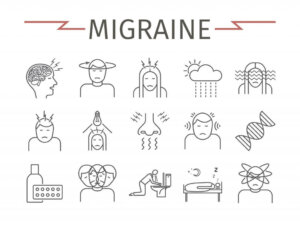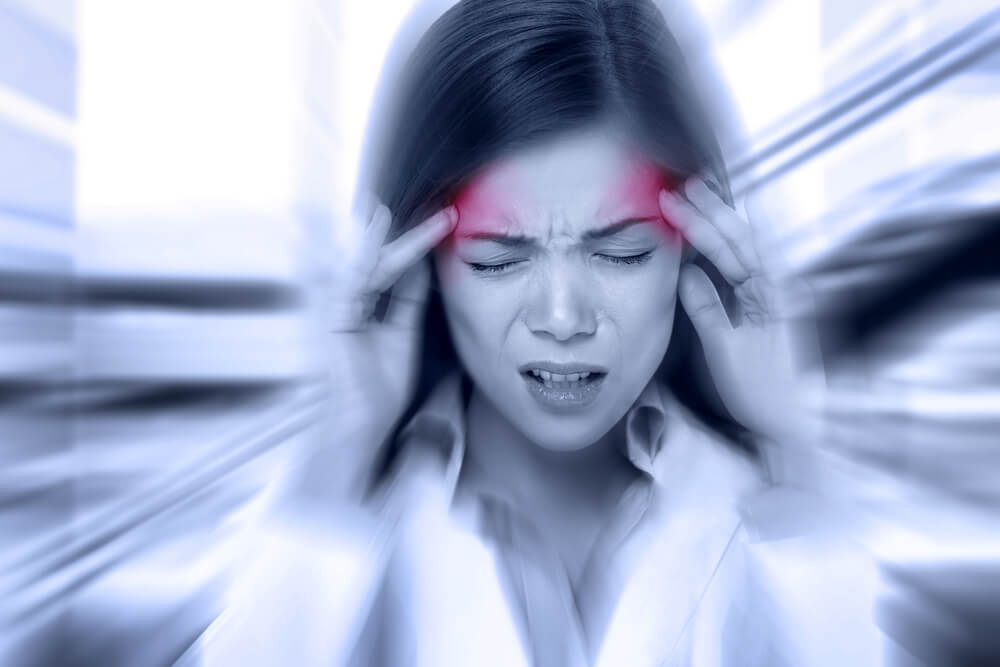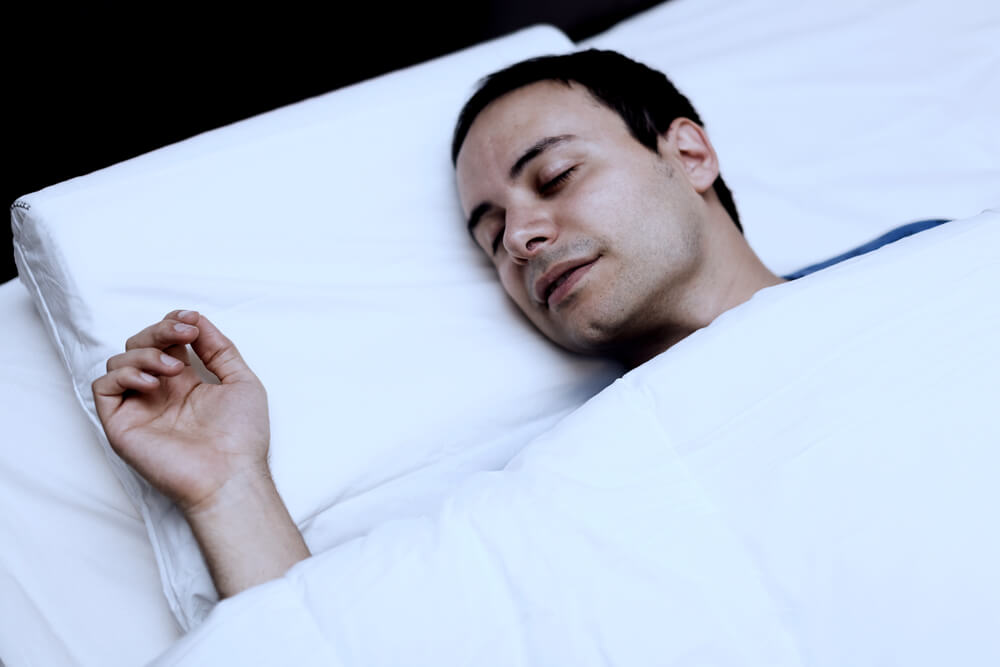What Is a Migraine?

Migraines affect approximately 10% of the population, which means that it’s a fairly common disorder. This condition reduces people’s quality of life as it can hinder their day-to-day life. So, what exactly is a migraine?
What is a migraine?
A migraine is a primary headache characterized by headache attacks that can even incapacitate those who suffer from them. The characteristics of a migraine attack are:
- A duration of between 4 and 72 hours.
- Variable intensity: from a mild pain that can be confused with a tension headache, to a moderate to severe headache.
- Pulsatile in nature (as if the person were hitting their heads with sheet metal).
- It’s usually located only on one side of the head.

Migraine attacks are usually accompanied by nausea, visual disturbances such as photophobia (intolerance to light) or with aura (flashes of light, blind spots,…) and hypersensitivity to sound. In addition, according to the frequency of the seizures, they can be classified into two types:
- Episodic: one that appears less than 15 days a month. Episodic migraine can become chronic.
- Chronic: the person suffers from a migraine for 15 or more days a month, and it’s a very disabling type of migraine.
The treatments available are aimed at relieving the headache and reducing the frequency of attacks. They can be divided into treatments aimed at reducing symptoms and treatments that try to prevent migraine attacks. The latter are often used in patients with migraines that are more difficult to control.
Read more here: Types of Migraine
Who is affected by this condition?
As we have discussed, approximately one in ten people suffer from migraine. In addition, 80% of those affected are women between 20 and 40 years old. That is why it’s one of the main causes of visiting the neurologist’s office.
It seems that it is sixth on the list of the diseases and conditions that impact humans most worldwide. This is because this type of headache is a health problem that affects the working life of the people who suffer from it, limiting the activities of their daily routine.
This largely depends on the intensity and duration of the pain. Especially people with chronic migraine are the ones who are most affected in this regard, often having to request sick leave or reduced working hours.
Why does a migraine occur?

What exactly causes migraines is not entirely clear. One of the theories states that it’s due to alterations in the blood vessels in the head.
This process begins with a first phase of vasoconstriction of the vessels and later, as a mechanism to counteract it, an intense vasodilation. This second phase would be responsible for the intense headache during crises.
On the other hand, it’s believed that it may have a genetic origin. In this case, neurons in the brain would be hypersensitive to changes in their environment and would be involved in the process of migraine attacks.
Other factors related to migraines
The diet
Eating habits have been linked to its chronification. Some drinks and foods such as alcohol, coffee, and chocolate seem to be related to the onset of headaches.
Physical exercise
Performing a physical exercise routine can help to prevent headaches associated with migraines, both in frequency and intensity.
Sleep well

Sleep is another factor that seems to be involved in the development of migraines. A poor sleep routine, as well as other conditions such as obstructive sleep apnea or bruxism that stop us from getting good sleep seem to be related to the duration of the headaches. Therefore, healthy sleep habits seem to be important.
Obesity and overweight
It seems that obesity is related to the risk of suffering from migraine, and also to the evolution from episodic migraines to chronic migraines.
Alcohol
It seems that alcohol is associated with the onset of migraine attacks. Headaches usually appear after drinking alcohol and up to 12 hours later.
Also, people with this type of headache tend to be more sensitive to the effects of alcohol. On the other hand, with some of the drugs indicated for migraine, drinking alcohol isn’t recommended, because it can interfere with its effects.
Migraines affect approximately 10% of the population, which means that it’s a fairly common disorder. This condition reduces people’s quality of life as it can hinder their day-to-day life. So, what exactly is a migraine?
What is a migraine?
A migraine is a primary headache characterized by headache attacks that can even incapacitate those who suffer from them. The characteristics of a migraine attack are:
- A duration of between 4 and 72 hours.
- Variable intensity: from a mild pain that can be confused with a tension headache, to a moderate to severe headache.
- Pulsatile in nature (as if the person were hitting their heads with sheet metal).
- It’s usually located only on one side of the head.

Migraine attacks are usually accompanied by nausea, visual disturbances such as photophobia (intolerance to light) or with aura (flashes of light, blind spots,…) and hypersensitivity to sound. In addition, according to the frequency of the seizures, they can be classified into two types:
- Episodic: one that appears less than 15 days a month. Episodic migraine can become chronic.
- Chronic: the person suffers from a migraine for 15 or more days a month, and it’s a very disabling type of migraine.
The treatments available are aimed at relieving the headache and reducing the frequency of attacks. They can be divided into treatments aimed at reducing symptoms and treatments that try to prevent migraine attacks. The latter are often used in patients with migraines that are more difficult to control.
Read more here: Types of Migraine
Who is affected by this condition?
As we have discussed, approximately one in ten people suffer from migraine. In addition, 80% of those affected are women between 20 and 40 years old. That is why it’s one of the main causes of visiting the neurologist’s office.
It seems that it is sixth on the list of the diseases and conditions that impact humans most worldwide. This is because this type of headache is a health problem that affects the working life of the people who suffer from it, limiting the activities of their daily routine.
This largely depends on the intensity and duration of the pain. Especially people with chronic migraine are the ones who are most affected in this regard, often having to request sick leave or reduced working hours.
Why does a migraine occur?

What exactly causes migraines is not entirely clear. One of the theories states that it’s due to alterations in the blood vessels in the head.
This process begins with a first phase of vasoconstriction of the vessels and later, as a mechanism to counteract it, an intense vasodilation. This second phase would be responsible for the intense headache during crises.
On the other hand, it’s believed that it may have a genetic origin. In this case, neurons in the brain would be hypersensitive to changes in their environment and would be involved in the process of migraine attacks.
Other factors related to migraines
The diet
Eating habits have been linked to its chronification. Some drinks and foods such as alcohol, coffee, and chocolate seem to be related to the onset of headaches.
Physical exercise
Performing a physical exercise routine can help to prevent headaches associated with migraines, both in frequency and intensity.
Sleep well

Sleep is another factor that seems to be involved in the development of migraines. A poor sleep routine, as well as other conditions such as obstructive sleep apnea or bruxism that stop us from getting good sleep seem to be related to the duration of the headaches. Therefore, healthy sleep habits seem to be important.
Obesity and overweight
It seems that obesity is related to the risk of suffering from migraine, and also to the evolution from episodic migraines to chronic migraines.
Alcohol
It seems that alcohol is associated with the onset of migraine attacks. Headaches usually appear after drinking alcohol and up to 12 hours later.
Also, people with this type of headache tend to be more sensitive to the effects of alcohol. On the other hand, with some of the drugs indicated for migraine, drinking alcohol isn’t recommended, because it can interfere with its effects.
- Grupo de investigación Health & Territory Research (HTR) de la Universidad de Sevilla. Impacto y situación de la Migraña en España: Atlas 2018. 2018.
- Grupo de trabajo del Protocolo para el manejo del paciente con migraña crónica. PROTOCOLO PARA EL MANEJO DEL PACIENTE CON MIGRAÑA CRÓNICA Red española de agencias de evaluación de Tecnologías y prestaciones del sistema nacional de salud. http://www.iacs.es/wp-content/uploads/2017/04/IACS_Protocolo_Migraña_Profesionales.pdf.
- Rothrock JF. Material Educativo de Cefaleas ¿Qué es la migraña?
- Deza Bringas L. La Migraña. Acta Med Per. 2010;27(2):129-136. doi:10.15446/av.enferm.v33n1.37514
Este texto se ofrece únicamente con propósitos informativos y no reemplaza la consulta con un profesional. Ante dudas, consulta a tu especialista.







